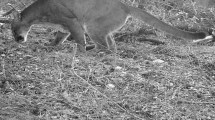Abstract
Intraspecific communication by solitary felids is not well understood, but it is necessary for mate selection and to maintain social organization. We used motion-triggered video cameras to study the use of communication behaviors in bobcats (Lynx rufus), including scraping, urine spraying, and olfactory investigation. We found that olfactory investigation was more commonly used than any other behavior and that—contrary to previous research—scraping was not used more often than urine spraying. We also recorded the use of cryptic behaviors, including body rubbing, claw marking, flehmen response, and vocalizations. Visitation was most frequent during January, presumably at the peak of courtship and mating, and visitation become more nocturnal during winter and spring. Our results add to the current knowledge of bobcat communication behaviors, and suggest that further study could enhance our understanding of how communication is used to maintain social organization. Videos relating to the behaviors in this article are available at: http://www.momo-p.com/showdetail-e.php?movieid=momo141104bn01a, http://www.momo-p.com/showdetail-e.php?movieid=momo141104bn02a, http://www.momo-p.com/showdetail-e.php?movieid=momo141104lr01a, http://www.momo-p.com/showdetail-e.php?movieid=momo141104lr02a, http://www.momo-p.com/showdetail-e.php?movieid=momo141104lr03a and http://www.momo-p.com/showdetail-e.php?movieid=momo141104lr04a.



Similar content being viewed by others
References
Allen ML, Wittmer HU, Wilmers CC (2014) Puma communication behaviours: understanding functional use and variation among sex and age classes. Behaviour 151:819–840
Bailey TN (1974) Social organization in a bobcat population. J Wildl Manag 38:435–446
Balme GA, Hunter LTB (2013) Why do leopards commit infanticide? Anim Behav 86:791–799
Candolin U (2003) The use of multiple cues in mate choice. Biol Rev 78:575–595
Cohen J (1992) A power primer. Psychol Bull 112:155–159
Kleiman DG, Eisenberg JF (1973) Comparisons of canid and felid social systems from an evolutionary perspective. Anim Behav 21:637–659
Larivière S, Walton LR (1997) Lynx rufus. Mamm Species 563:1–8
Logan K, Sweanor L (2001) Desert puma: evolutionary ecology and conservation of an enduring carnivore. Island, Washington, DC, p 464
Lovallo MJ, Anderson EM (1996) Bobcat (Lynx rufus) home range size and habitat use in northwest Wisconsin. Am Midl Nat 135:214–252
McBride R, McBride C (2010) Florida panther flehmen response recorded at baited trail camera site. Southeast Nat 9:629–631
McBride R, Sensor R (2012) Photographic evidence of wild Florida panthers scent–marking with facial glands. Southeast Nat 11:349–354
Mellen JD (1993) A comparative analysis of scent-marking, social and reproductive behavior in 20 species of small cats. Am Zool 33:151–166
Meyer D, Zeileis A, Hornik K (2013) VCD: visualizing categorical data. R package version 1.3-1. http://CRAN.R-project.org/package=vcd
Moriarty JG, Riley SPD (2011) Survival and dispersal of bobcat kittens in a fragmented urban landscape. Final report. Western National Parks Association, Oro Valley
R Core Team (2013) R: a language and environment for statistical computing. R Foundation for Statistical Computing, Vienna
Smith JLD, McDougal C, Miquelle D (1989) Scent marking in free-ranging tigers, Panthera tigris. Anim Behav 37:1–10
Sokal RS, Rohlf FJ (1987) Introduction to biostatistics. W.H. Freeman and Co., New York
Verberne G, Leyhausen P (1976) Marking behaviour of some Viverridae and Felidae: time-interval analysis of the marking pattern. Behaviour 58:192–253
Wassmer DA, Guenther DD, Layne JL (1988) Ecology of the bobcat in south-central Florida. Bull Fla State Mus Biological Sci 33:159–228
Wilmers CC, Wang Y, Nickel B, Houghtaling P, Shakeri Y, Allen ML, Kermish-Wells J, Yovovich V, Williams T (2013) Scale dependent behavioural responses to human development by a large predator, the puma. PLoS One 8:e60590
Yule GU (1912) On the methods of measuring the association between two attributes. J R Stat Soc 75:579–652
Acknowledgments
Funding was provided by NSF grant #0963022, and the Gordon and Betty Moore Foundation, the University of California at Santa Cruz, the University of California at Davis, and the California Department of Fish and Wildlife. We thank P. Houghtaling, Y. Shakeri, and many field technicians for their contributions to the project. We thank Y. Wang and two anonymous reviewers for providing comments on earlier drafts of the manuscript that improved its quality.
Author information
Authors and Affiliations
Corresponding author
About this article
Cite this article
Allen, M.L., Wallace, C.F. & Wilmers, C.C. Patterns in bobcat (Lynx rufus) scent marking and communication behaviors. J Ethol 33, 9–14 (2015). https://doi.org/10.1007/s10164-014-0418-0
Received:
Accepted:
Published:
Issue Date:
DOI: https://doi.org/10.1007/s10164-014-0418-0




